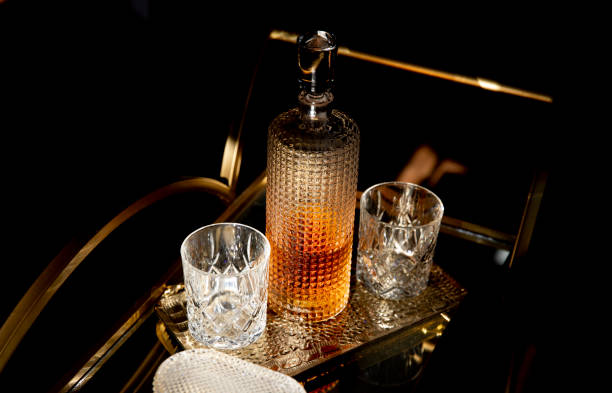
In the world of spirits, few beverages carry the mystique and allure of whisky. At the heart of the allure of whisky lies the ageing process. The passage of time, combined with the interplay of wooden barrels is the reason for the distinct character. Complexity and depth of whisky. This relationship is more prominent in the world of bourbon. Where craftsmanship, tradition and innovation combine to create the highly sought-after spirits that are available on the market today.
The Whisky Distillation Process: Crafting Liquid Gold
Whisky is essentially distilled beer that is made from water. Malted barley, yeast, and other grains such as corn, rye, or wheat. The distillation procedure is long and entails heating the mixture to come up with vaporised alcohol that gets condensed back. The final result is a highly condensed alcoholic product that has a strong characteristic of the products used in the distillation process.
Different types of whisky, including bourbon, scotch, and Irish whiskey, employ distinct variations of this process. For example, bourbon, a uniquely American creation, primarily uses corn as its main grain. And is often known for its slightly sweet and robust flavour profile. Conversely, Scotch is manufactured using natural malted barley that has undergone a substantial ageing period.
Pro Tip: You can learn more about whiskey ingredients, and the entire process by reading this detailed guide.
Ageing: The ageing process is where whisky truly comes into its own. It’s during this maturation period that the interaction between wooden barrels and the liquid gold is given prominence and this ends up in shaping the colour, profile and the overall flavour.
The choice of barrel is paramount. Oak barrels, the most commonly used vessel for ageing whisky, are porous and allow the spirit to breathe and interact with the wood. The wood extracts compounds from the spirit, such as tannins, lignins, and vanillin, while simultaneously infusing flavours from the barrel itself.
American white oak barrels, often previously used for ageing bourbon, are a popular choice for maturing whisky. These barrels lend vanilla, caramel, and sometimes coconut notes to the spirit.
The climate in which the whisky is aged also plays a significant role. In regions with more dramatic temperature fluctuations, such as Kentucky, the whisky expands and contracts within the barrel, allowing for greater interaction between the liquid and the wood. This results in a quicker and more intense ageing process, compared to regions with more stable climates like Scotland.
Bourbon: A Pinnacle of Aging Artistry
Bourbon, America’s native spirit, embodies the profound impact of ageing. To be legally labelled as bourbon, the spirit must be distilled from a grain mixture containing at least 51% corn and aged in new charred oak barrels.
Bourbon brands like Pappy Van Winkle, Buffalo Trace’s Antique Collection, and Blanton’s consistently receive high praise from enthusiasts and critics alike. Pappy Van Winkle, in particular, has achieved a cult-like status, with its 15, 20, and 23-year-old expressions fetching astronomical prices at auctions.
These bourbons showcase the intricate balance between the spirit and the barrel. The longer ageing periods allow for a more nuanced and complex flavour profile. Notes of caramel, vanilla, butterscotch, oak, and even hints of dark fruit and spices can emerge. Offering a sensory journey that reflects the whisky’s journey through time and wood.
If you would like to learn more about bourbon, how to choose the best bourbon, and the available affordable options, then this article is for you.
The Art and Science of Tasting: Appreciating Aged Whisky
As whisky ages, it generally darkens due to the extraction of compounds from the wood. When nosing a glass of whisky, one is greeted with an array of aromas that reveal the spirit’s complexity. Coming into contact with wood and the spirits brings about diverse scents or aromas and in most instances they range from vanilla,caramel and more!
Finally, the tasting itself brings all the sensory elements together. The initial sip may showcase the sweetness of caramel and vanilla, followed by layers of oak, spice, and fruit. The finish and the aftertaste will still be lingering on the palate, and this is what shows how complex the whisky is.
The Endless Journey of Whisky
The alchemical change which takes place inside an oak barrel is something that is hard to understand. It is some kind of a marvel. In the case of bourbon, the interplay between corn-based distillation and oak ageing creates a symphony of flavours that dance across the palate.
So, whenever you toast to a glass of whisky, you shouldn’t just be savouring the taste. But also appreciate the history and the effort that went into the process of making your favourite drink.
The Final Verdict
Nothing replaces the ageing process in the world of whisky. The intricate balance between wooden barrels as well as the passage of time helps to transform a raw spirit into a symphony of flavours. And aromas that portray a story of craftsmanship, tradition, and innovation. The character of whisky, shaped by the alchemy of ageing, is a testament to the magic that occurs. When time meets oak. It’s a reminder that some things are worth the wait, and in the case of aged whisky, the wait is richly rewarded with each sip.